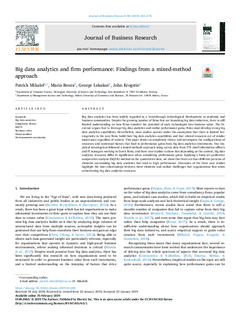| dc.contributor.author | Mikalef, Patrick | |
| dc.contributor.author | Boura, Maria | |
| dc.contributor.author | Lekakos, George | |
| dc.contributor.author | Krogstie, John | |
| dc.date.accessioned | 2020-01-20T08:43:12Z | |
| dc.date.available | 2020-01-20T08:43:12Z | |
| dc.date.created | 2019-07-03T07:36:08Z | |
| dc.date.issued | 2019 | |
| dc.identifier.citation | Journal of Business Research. 2019, 98 261-276. | nb_NO |
| dc.identifier.issn | 0148-2963 | |
| dc.identifier.uri | http://hdl.handle.net/11250/2636922 | |
| dc.description.abstract | Big data analytics has been widely regarded as a breakthrough technological development in academic and business communities. Despite the growing number of firms that are launching big data initiatives, there is still limited understanding on how firms translate the potential of such technologies into business value. The literature argues that to leverage big data analytics and realize performance gains, firms must develop strong big data analytics capabilities. Nevertheless, most studies operate under the assumption that there is limited heterogeneity in the way firms build their big data analytics capabilities and that related resources are of similar importance regardless of context. This paper draws on complexity theory and investigates the configurations of resources and contextual factors that lead to performance gains from big data analytics investments. Our empirical investigation followed a mixed methods approach using survey data from 175 chief information officers and IT managers working in Greek firms, and three case studies to show that depending on the context, big data analytics resources differ in significance when considering performance gains. Applying a fuzzy-set qualitative comparative analysis (fsQCA) method on the quantitative data, we show that there are four different patterns of elements surrounding big data analytics that lead to high performance. Outcomes of the three case studies highlight the inter-relationships between these elements and outline challenges that organizations face when orchestrating big data analytics resources. | nb_NO |
| dc.language.iso | eng | nb_NO |
| dc.rights | Attribution-NonCommercial-NoDerivatives 4.0 Internasjonal | * |
| dc.rights.uri | http://creativecommons.org/licenses/by-nc-nd/4.0/deed.no | * |
| dc.title | Big data analytics and firm performance: Findings from a mixed-method approach | nb_NO |
| dc.type | Journal article | nb_NO |
| dc.type | Peer reviewed | nb_NO |
| dc.description.version | publishedVersion | nb_NO |
| dc.source.pagenumber | 261-276 | nb_NO |
| dc.source.volume | 98 | nb_NO |
| dc.source.journal | Journal of Business Research | nb_NO |
| dc.identifier.doi | 10.1016/j.jbusres.2019.01.044 | |
| dc.identifier.cristin | 1709639 | |
| dc.description.localcode | © 2019 The Authors. Published by Elsevier Inc. This is an open access article under the CC BY-NC-ND license (http://creativecommons.org/licenses/BY-NC-ND/4.0/). | nb_NO |
| cristin.unitcode | 194,63,10,0 | |
| cristin.unitname | Institutt for datateknologi og informatikk | |
| cristin.ispublished | true | |
| cristin.fulltext | preprint | |
| cristin.qualitycode | 2 | |

